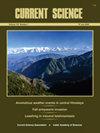Petrogenesis and geochemical characteristics of pyroxenite dykes in and around Salem Mafic–Ultramafic complex, southern India: an arc-related origin of Alaskan-type
IF 1.1
4区 综合性期刊
Q3 MULTIDISCIPLINARY SCIENCES
引用次数: 0
Abstract
Arc-related origin of pyroxenites in association with Alaskan-type tectonics has been described in many mafic–ultramafic complexes across the globe. The Salem Mafic–Ultramafic Complex (SMUC) is one such Neo-p roterozoic Alaskan-type complex exposed at the north-er n margin of the Cauvery Suture Zone (CSZ), Southern Granulite Terrane, south India. The Complex consists of mafic and ultramafic sequences along with several occurrences of pyroxenite intrusions of varied thick-ness in the form of dykes. Similar pyroxenite dykes were also observed in and around the Complex at several locations within the basement hornblende gneiss, trending in the NE–SW and E–W directions. Petrography of these dykes indicated websterite variety with cumulate textures and reveals the dominance of clinopyroxene along with orthopyroxene, primary amphi bole, minor plagioclase and oxide minerals like magnetit e, ilmenite and spinels. The whole-rock chemistry of 10 representative samples showed enrichment of LIL elements (Sr, K, Rb, Th) and depletion of HFSE (Hf, Ti, Y, Yb) with normalized primitive mantle and N-MORB . The clinopyroxene mineral chemistry represented tholeiitic signatures with high Mg# values (Mg/(Mg + Fe)) up to 0.91, and the two-pyroxene thermobarometry of these pyroxenites yielded re-equilibrium crystallization temperatures of 820–932 C with moderate pressures at 11–12 kbar. Various tectonic discrimination plots of clinopyroxene mineral chemistry together with whole-rock chemistry favoured their origin under arc settings with the interactions of fluid-related subduction zone m etasomatism relevant to Neoproterozoic Alaskan-typ e tectonics.印度南部塞勒姆镁铁质-超镁铁质杂岩及其周围辉石岩脉的岩石成因及地球化学特征:阿拉斯加型弧相关成因
在全球许多基性-超基性杂岩中都描述了与阿拉斯加型构造有关的辉石岩弧相关成因。塞勒姆镁铁质-超镁铁质杂岩(SMUC)是暴露在印度南部南麻粒岩地体Cauvery缝合带(CSZ)北缘的新元古代阿拉斯加型杂岩之一。杂岩由基性和超基性层序组成,并伴有几处不同厚度的辉石岩侵入岩,呈岩脉状。在基底角闪片麻岩内的几个位置及其周围也观察到类似的辉石岩脉,走向为NE-SW和E-W方向。这些岩脉的岩石学特征显示出websterite的多样性和堆积结构,并以斜辉石为主,伴着正辉石、原生两角岩孔、少量斜长石和氧化矿物如磁铁矿、钛铁矿和尖晶石。10个代表性样品的全岩化学特征表明,在归一化的原始地幔和N-MORB作用下,轻铁元素(Sr、K、Rb、Th)富集,高铁元素(Hf、Ti、Y、Yb)亏缺。斜辉石矿物化学特征为高mg#值(Mg/(Mg + Fe))达0.91的拉斑岩特征,其双辉石热气压测定结果为再平衡结晶温度820 ~ 932℃,中压11 ~ 12 kbar。斜辉石矿物化学及全岩化学的各种构造判别图表明,斜辉石的成因与新元古代阿拉斯加型构造相关的流体相关俯冲带与交代作用的相互作用有关。
本文章由计算机程序翻译,如有差异,请以英文原文为准。
求助全文
约1分钟内获得全文
求助全文
来源期刊

Current Science
综合性期刊-综合性期刊
CiteScore
1.50
自引率
10.00%
发文量
97
审稿时长
3 months
期刊介绍:
Current Science, published every fortnight by the Association, in collaboration with the Indian Academy of Sciences, is the leading interdisciplinary science journal from India. It was started in 1932 by the then stalwarts of Indian science such as CV Raman, Birbal Sahni, Meghnad Saha, Martin Foster and S.S. Bhatnagar. In 2011, the journal completed one hundred volumes. The journal is intended as a medium for communication and discussion of important issues that concern science and scientific activities. Besides full length research articles and shorter research communications, the journal publishes review articles, scientific correspondence and commentaries, news and views, comments on recently published research papers, opinions on scientific activity, articles on universities, Indian laboratories and institutions, interviews with scientists, personal information, book reviews, etc. It is also a forum to discuss issues and problems faced by science and scientists and an effective medium of interaction among scientists in the country and abroad. Current Science is read by a large community of scientists and the circulation has been continuously going up.
Current Science publishes special sections on diverse and topical themes of interest and this has served as a platform for the scientific fraternity to get their work acknowledged and highlighted. Some of the special sections that have been well received in the recent past include remote sensing, waves and symmetry, seismology in India, nanomaterials, AIDS, Alzheimer''s disease, molecular biology of ageing, cancer, cardiovascular diseases, Indian monsoon, water, transport, and mountain weather forecasting in India, to name a few. Contributions to these special issues ‘which receive widespread attention’ are from leading scientists in India and abroad.
 求助内容:
求助内容: 应助结果提醒方式:
应助结果提醒方式:


